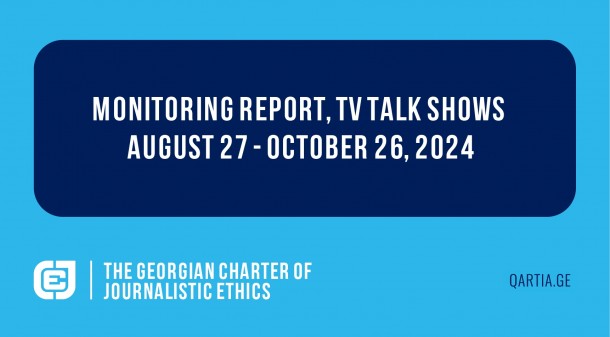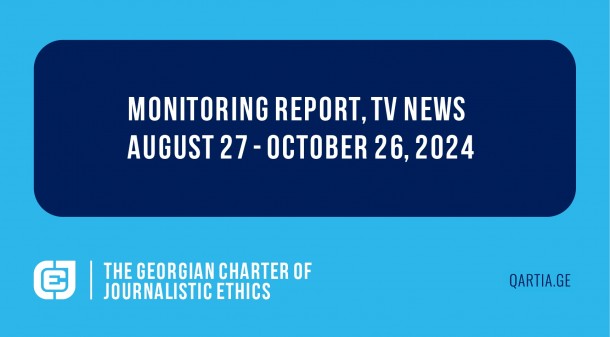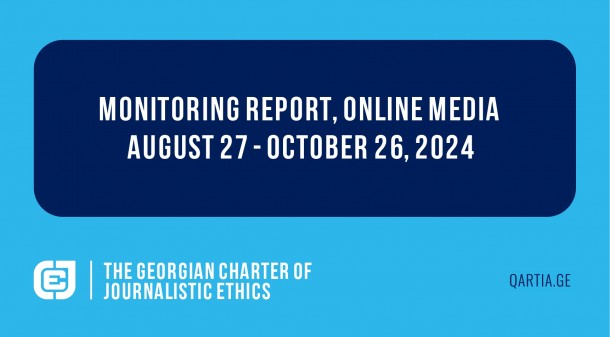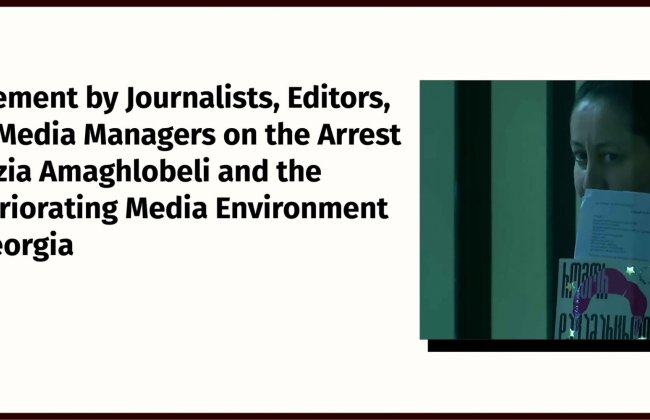20.10.2013
Tbilisi, 26 September 2013 – The Charter of Journalistic Ethics, an
independent, non-profit professional journalist association that
promotes the values of freedom and democracy, has been
systematically monitoring the media coverage of the 27 October
presidential election. This project is conducted in cooperation
with the Slovak media-monitoring organization MEMO 98 and with the
support of the Open Society Foundation Georgia (OSFG).Following is the summary of the main monitoring findings covering two weeks of the official campaign period (2 – 15 September):
EXECUTIVE SUMMARY
Most of monitored media have so far provided a generally balanced coverage of political parties and candidates in their political and election-related prime time news reporting. The media devoted the bulk of their news coverage to the activities of the government and the two main parties – the United National Movement and the Georgian Dream. News coverage of the campaign has so far focused primarily on campaign rallies. Voters would benefit from a more analytical and in-depth coverage that could help them to better analyze and assess the qualities and programmes of electoral contestants. While the media generally follow the principles outlined in the Code of Conduct for Elections, there were a few instances where these principles were violated.
The preliminary media monitoring results for the period of 2 – 15 September indicate that most media have so far provided a generally balanced coverage of political parties and candidates in their political and election-related prime time news reporting. At the same time, however, the news coverage of the campaign has so far focused primarily on campaign events with little or no focus on issues and differences between the candidates. Voters would benefit from a more analytical and in-depth coverage that could help them to better analyze and assess the qualities and programmes of electoral contestants.[1]
In the publicly-funded GPB1 newscasts, both the Georgian Dream (GD) and the United National Movement (UNM) received almost equal proportions of mostly neutral coverage (15,9 and 16,4 per cent respectively). The most presented political entity was the government that received 42,9 percent of mainly neutral coverage. By comparison, the coverage of the president totaled 7,5 percent – it was also mainly neutral.
The qualitative analysis of GPB1 has so far indicated that the channel adheres to the Code of Conduct, with most of its news items being balanced and unbiased. There were only a very few occasions when GPB1 departed from this approach. For example, on 15 September, Moambe news programme featured an interview with the president that lasted some 2 minutes and 40 seconds. During the interview, the president criticized the prime minister for stopping the project of the railway bypass through Tbilisi, using a strong language: “ I want to urge the prime minister to come to senses because it is his personal decision. Why is this project stopped? What is the matter? Maybe he thinks it is Chorvila’s (the prime minister’s village) hiking path.” The public broadcaster has not attempted to obtain a response from either the prime minister or any other members of the government.
When covering the campaign, GPB mostly does it by means of coverage from the campaign events. In the second part of the Moambe, all candidates are usually given approximately one minute and their meetings are presented by the standard phrase: “He/she has met the voters and presented them with his/her presidential platform.” To date, GPB has not been providing more details on positions of different candidates on various issues and how they would try to solve them if elected.
Similar to GPB1, the privately owned Rustavi 2 also devoted the bulk of its prime time news coverage to the activities of the cabinet ministers (38,5 per cent of the coverage). While this coverage was mainly neutral in tone, there was also negative coverage of the government (more than on any other monitored channel). In addition, the channel gave more coverage to the UNM (24,2 per cent) than the GD (13,3 per cent). While 25 per cent of the UNM coverage was positive and only 5 was negative, as much as 15 per cent of the GD coverage was negative and 15 per cent was positive. The president received 8,5 percent of the coverage that was mainly neutral.
The qualitative analysis of Rustavi 2 has so far indicated that the channel adheres to the Code of Conduct, with most of its news items being balanced and unbiased. On one occasion, however, the monitoring team observed that the channel did not fully adhered to the Code and showed a story where balance was not fully observed. This story was broadcast on 14 September (in “Kurieri”) and it featured description of the Georgian economy. After a five-minute long criticism of the incumbent government, the Minister of Finance had some 23-25 seconds to defend the government’s position. This was not proportional to the allegations waged by the anchor and two experts presented in the story.
Another private channel Imedi also allotted the largest portion of coverage (62,3 per cent) to the government – the tone of the coverage was mainly neutral. The two main parties – UNM and GD – received similar proportions of mostly neutral coverage (13,4 per cent and 8,6 per cent respectively). The activities of the president were devoted 5,9 percent of mainly neutral coverage.
Similar to GPB1 and Rustavi 2, the qualitative analysis of Imedi has so far indicated that most of its news items are balanced. The monitoring team, however, noticed a few stories that were largely uncritical of the incumbent government. For example, on September 6, Imedi broadcast a story dedicated to open prisons. The whole story was a positive presentation of the government, featuring the deputy minister of corrections and legal assistance in a positive context, uchalenged by anyone whose position on this project might be different.
Similar to GPB 1, Maestro TV devoted almost identical coverage to the UNM and the GD (16,1 and 15,4 per cent respectively). The most covered entity was the government with 49,1 percent of the coverage. As for the president, he received 7,9 percent. All this coverage was mainly neutral in tone.
The qualitative analysis of Maestro has so far indicated that most of its news items are balanced and unbiased. On 5 September, however, Maestro featured a nine-minute long item on destruction of secret recordings showing private life. While the former government was blamed for the crimes committed in this respect, there were no comments from any UNM member. In the part of the item that relates to the incumbent government initiative, a news reporter informed that the position of UNM was unknown at the time of reporting.
By contrast, the local Tbilisi-based Kavkazia adopted a different approach. It devoted almost half of its political and election-related news coverage to the government – as much as 46 per cent of this coverage was positive and only 14 per cent negative. As for the presentation of the two main parties, GD and UND received 14,9 and 21,1 percent respectively. Fifty eight per cent of the GD coverage was positive and only ten percent was negative. As for the coverage of UNM, it was mainly neutral and positive. The president received some three per cent of the coverage that was mainly neutral.
TV Adjara devoted as much as 73,1 percent of its political and election-related news coverage to the activities of the government – this coverage was overwhelmingly neutral. The GD received two times more coverage than the UNM (10,3 per cent and 4,7 per cent respectively) of mainly neutral coverage. The government of Adjara received some 7,3 percent of mainly neutral coverage.
The qualitative analysis of Adjara has so far indicated that the channel adheres to the Code of Conduct, with most of its news items being balanced and unbiased. There were only a very few occasions when TV Adjara departed from this approach. For example, on 9 September, a news item showed a protest by local residents in Kirnati village against the government (in relation to a construction of a hydro electricity power station). No one from the government was approached to comment.
Conclusion
Data from the first two weeks of media monitoring by the Charter & MEMO 98 reveals that most monitored media have provided a generally balanced coverage, focusing primarily on the government and the two main parties and their candidates. A few occasions occurred, however, where TV channels neglected to offer viewers opposing views on particular stories. The Charter & MEMO 98 will continue their monitoring throughout the pre-election period to determine if these are consistent trends. The next report will also include analysis of the coverage of presidential candidates and of the current affairs programmes (debates & talk shows).
Methodology
The Charter & MEMO 98 have sought to evaluate the mass media’s performance in providing objective and balanced coverage of contestants and their platforms so the citizens of Georgia can make well-informed choices at the ballot box. The project’s findings have been determined through a well-defined and rigorous methodology and are not intended to support any one candidate or political party, but the integrity of the media environment as a whole during the campaign season. On 2 September, the Charter commenced the monitoring of six TV channels (GPB, Rustavi 2, Imedi TV, Maestro TV, Kavkazia and Adjara TV).[2]
The Charter uses methodology that has been developed by MEMO 98 which has carried out similar projects in 47 countries in the last 15 years. Given its comprehensive content-oriented approach, it is specially designed to provide in-depth feedback on pluralism and diversity in media reporting, including coverage of chosen subjects/themes. As such, the outcome of the monitoring is not a set of empty and superficial data, but a detailed analysis and evaluation of the current level of political diversity in media reporting, examined in the proper context, including concrete comparisons and analysis.[3] The Charter & MEMO 98 will issue two more preliminary reports and a comprehensive final report, including recommendations for potential improvements, in four weeks.






